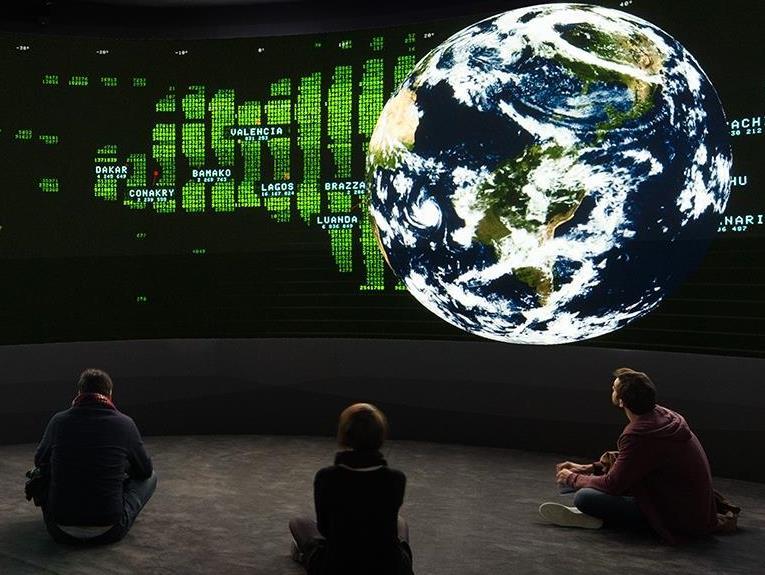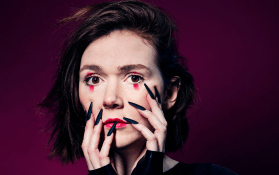Detail of exhibition EXIT at UNSW Galleries, as part of Sydney Festival programing; courtesy the gallery
Festivals are good business. They draw tourism to a city, bring together new partners and stakeholders, and offer opportunities for the commissioning new work. That would have to be a win-win-win, except that there is one problem with this growing uber model. The visual arts are increasingly being sidelined.
Fergus Linehan, CEO and Director of Edinburgh International Festival, admitted that this was not a new omission, just an escalating one.
‘The year I did Sydney Festival (2006-09) there was almost no visual arts,’ he said on a recent panel with Sydney Festival Artist Director Wesley Enoch and Co-Artistic Director of Adelaide Festival Rachel Healy.
Read: What are festivals for?
Linehan was resigned to the absence of visual arts, but this huge oversight is a lost opportunity. Given the often hefty ticket prices commanded by many performing arts and music events, free exhibitions and large-scale public sculpture or installations are the perfect balance to engage a broader audience.
In the face of the global trend to build cities as cultural precincts, the behind-doors, ticket-holders-only performances that dominate festival programming would seem to be counter intuitive.
Why then aren’t the visual arts treated with the same weight and program consideration as the performing arts? It was a question we put to several creatives during this high summer festival season.
The exhibition traded for entertainment
Enoch believes it has to do with timing. ‘Exhibitions need longer than a festival. Good exhibitions should be up for more than just a couple of festival weeks.’
There is also a financial disincentive, he admits. ‘While the big blockbuster shows happen, visual art by its very nature can use a lot of money with very little income coming in through ticket sales.’
Enoch has programmed a mere three exhibitions in his 130 event-strong Sydney Festival. In a gesture to bolster that, he has added under the program category “Visual arts + Installations” another eight events . However, these are arguably more performance-based activities or “public entertainment” style events, such as the Sydney Dance Company performance within the Art Gallery of NSW’s Nude exhibition.
Another is The Beach – an installation of a million polyethylene balls at Barangaroo’s the Cutaway created by New York-based art and architecture practice Snarkiture. It is a popular draw card but, as art, little more than Gymboree-on-steroids.
Similarly, Glitterbox – an interactive mirrored installation that punters dance within, and House of Mirrors – a labyrinth of optical illusions to navigate at the Festival Village – have more of a side-show quality than a serious delving into the visual arts as a creative language. The only theme or box they tick is populist entertainment.
Enoch is aware of the dangers in delivering only playground visual art. ‘I don’t want to poo-poo art for art’s sake. It can be beautiful and meaningful. That is why those three exhibitions are in our program (Myuran Sukumaran at Campbelltown Arts Centre, Vernon Ah Kee at the NAS Gallery, and EXIT at UNSW Art & Design) – we have chosen to champion as they have something to say about the world.’
CAC received funding from Sydney Festival in support of its Sukumaran exhibition, Another Day in Paradise but the NAS Gallery did not get funding for Ah Kee. AGNSW was assisted by the festival to host performance but not for a visual arts event.

Artist / curator Ben Quilty, Sydney Festival Director Wesley Enoch and CAC Director Michael Dagostino discuss Myuran Sukumaran’s exhibition; photo Daniel Boud
The majority of exhibitions within festival programming are left to individual institutions to facilitate and fund, their inclusion simply a “partnering opportunity” for visibility and marketing.
In terms of funding festival exhibitions, Director of Campbelltown Arts Centre (CAC) Michael Dagostino said simply: ‘We asked – we always ask!’
‘I think the Sydney Festival has never been that great at visual arts. There are a few exceptions, but on the whole the major institutions get included regardless of what they are producing because it’s a value add that costs them very little.
‘Whether the Festival’s mandate should be visual art is beyond my call but I think they should be doing more visual art without a doubt,’ he added.
One argument is that the decline of visual arts in festival programming has coincided with the rise of biennale, triennials and art fairs internationally.
The flipside of that argument is that festivals are about cities, and defining their DNA, and that means touch points to all aspects of that society.
Read: Why it always feels like the festival season
How festivals compare
One festival that has made a conscious effort to support the visual arts is Perth International Art Festival (PIAF). In 2008, under the Directorship of Shelagh Magadza, PIAF appointed curator and independent arts consultant Margaret Moore as the visual arts program manager.
Laetitia Wilson writes: ‘Through Moore’s vision, visual arts acquired a new prominence. Driven to elevate the genre, Moore initiated a dedicated publication, distinct from the festival guide, focused entirely on the visual arts.
‘Since 2009 this document has come into its own as a stimulating festival publication, communicating information and promoting the exhibitions. Curatorial essays now offer a probing point of entry into what might otherwise seem like a disparate assortment of art shows.’
This year PIAF continues that commitment, yet visual arts are still swallowed by the emphases placed on the performing arts – the global festival raison d’être. Of 255 events listed on their website, only 14 are categorised as visual arts.
It should be noted, however, that of those 14 events nine are presented in galleries and are true visual arts programming. That is the highest proportion of exhibitions in an Australian festival.

Detail of filmmaker John Akomfrah Untitled, 2016. He brings two new major film installations to PIAF this year; © Smoking Dogs Films; Courtesy the Artist; Lisson Gallery, London
Adelaide Festival, by comparison, is a much smaller festival, with only 31 primary events listed in its program. Four of those are dedicated visual arts events, plus one interactive public art installation.
Adelaide Festival has traditionally held a week devoted to the Visual Arts and another to writing during its program, but it wound up its Artist’s Week in 2014, largely handing over that responsibility to the major arts organisations.
This appears to be the trend globally. Let them do it and we will give them a bit of marketing exposure – too easy!
The rhetoric is wrapped up in the golden glow of “cooperative relationships” and “partnering”, where a strong curatorial ethos can be presented and promoted, and yet the festival has minimal investment.
Are the visual arts selling themselves short? Or like CAC and NAS Gallery, do we need to be more ballsy in ensuring our place in these festivals by proposing exhibitions well in advance. Perhaps the responsibility of visual art institutions is not just to time an exhibition appropriately, but to campaign for better inclusion with festival organisers.
The conversations surrounding festivals today is one that speaks of a holistic vision – where the arts are not necessarily distinct, but integrated across disciplines. This year’s PIAF Director, Wendy Martin, explained: ‘Where there is cross pollination across all the artforms and audiences follow narratives that thread the performing arts to the visual arts and music, so that across the festival there’s a story.
‘It is important that generally for a festival there are things that people stumble across, so that work is not just for the initiated, so that people might encounter beautiful or mad things as they wander through the city,’ she added.
On a global scale, rhetoric and programming don’t seem to be syncing up here. Festivals should not be side-lining the visual arts, but rather bolstering their role in growing this cultural phenomenon.
MoFo (Hobart): 18 – 27 January
Sydney Festival: 7 – 29 January
Perth International Arts Festival (PIAF): 10 February – 3 March
Adelaide Fringe: 17 February – 19 March
Adelaide Festival: 3 – 19 March





